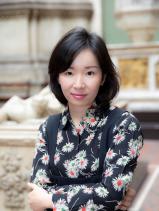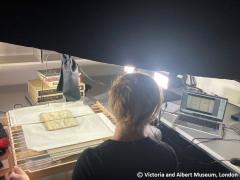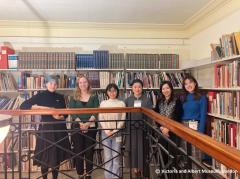-
ARC-iJAC Project Spotlights: An Interview with Masami Yamada (Curator, Asia Department, Victoria & Albert Museum)July 19, 2023(Wed)
Background:
Masami Yamada, leader of the ARC-iJAC project Re-thinking Japonisme: Digitization of the V&A's collection of Japanese illustrated books and researching its formation in the late 19th century, is a Curator in the Victoria and Albert Museum's Asia Department. She has particular responsibility for the collections of Japanese lacquerware, netsuke, ukiyo-e woodblock prints and contemporary craft. Her current area of research is contemporary craft, particularly the work of urushi lacquer artists. In 2022, she received the inaugural Sir Nicholas Goodison Award for Contemporary Craft from the Art Fund to further develop the Museum's internationally renowned Japanese lacquer collection.Thank you very much for your time today. How did you first connect with the Art Research Center (ARC) or hear about the International Joint Digital Archiving Center for Japanese Art and Culture (ARC-iJAC)?

Yamada: The V&A was the first museum where Professor Ryо̄ Akama from the ARC conducted the digitization of a Japanese art collection in Europe 20 years ago. In this first phase of the partnership project, every single artwork from the Museum's extensive collection of ukiyo-e woodblock prints, numbering over 25,000 in total, was photographed. These images were subsequently uploaded onto the Museum's publicly accessible collection database, Explore the Collections. It was a remarkable achievement in the early 2000s when the digital presence of museums was fairly limited.
Soon after I joined the V&A in 2018, I had a chance to meet with Professor Akama and Dr. Ryо̄ko Matsuba, Lecturer in Digital Japanese Arts and Humanities at the Sainsbury Institute for the Study of Japanese Arts and Cultures (SISJAC), in London to discuss the possibility of initiating the second phase of the digitization project. The collections of ukiyo-e prints and illustrated books remain largely uncatalogued and without photographs in the case of the book collection. We agreed that there was much scope to improve the visibility and accessibility of these important collections. So, a collaborative project with the ARC was something I planned to initiate from the very beginning of my time at the V&A.
Could you please tell us the motivation and significance for your ARC-iJAC research project Re-thinking Japonisme: Digitization of the V&A's collection of Japanese ukiyo-e prints and illustrated books and researching its formation in the late 19th century?
Yamada: The current research project, launched in 2022, is expected to take at least a few years to complete considering the volume of the target areas. The prime objective is to systematically digitize the ukiyo-e woodblock prints and illustrated books in the V&A collection to provide a more comprehensive overview.
 To date, three publications in English and two in Japanese on the ukiyo-e collection have been released between the 1980s and late 2000s. The 170 selected works traveled to Tokyo in 2007 for a special exhibition, Masterpieces of Ukiyo-e from the Victoria and Albert Museum, held at the Ōta Memorial Museum of Art in Tokyo, contributing to the collection's recognition in Japan. However, the selection of prints for these previous publications and the exhibition tended to focus on the most iconic prints of the ukiyo-e genre. The number of prints we can display in our permanent gallery of Japanese art is limited to no more than 15 at a time. I am excited to make thousands of prints that have never been displayed or published before accessible online through this project.
To date, three publications in English and two in Japanese on the ukiyo-e collection have been released between the 1980s and late 2000s. The 170 selected works traveled to Tokyo in 2007 for a special exhibition, Masterpieces of Ukiyo-e from the Victoria and Albert Museum, held at the Ōta Memorial Museum of Art in Tokyo, contributing to the collection's recognition in Japan. However, the selection of prints for these previous publications and the exhibition tended to focus on the most iconic prints of the ukiyo-e genre. The number of prints we can display in our permanent gallery of Japanese art is limited to no more than 15 at a time. I am excited to make thousands of prints that have never been displayed or published before accessible online through this project.The presence of the illustrated book collection, on the other hand, remains largely unknown despite its incredibly rich contents. There is only one publication on the collection compiled by Leonard G. Dawes in 1972. It introduced just a small selection of the most important titles, and there is currently no other publicly available resource to explore over 700 titles in the collection in full.
Our immediate focus is on the large group of Japanese prints and books acquired in 1886. The Museum purchased over 12,000 prints and 300 books as a single lot from a London-based art dealer, S. M. Franck, at the height of the European craze for all things Japanese. Analyzing print and book genres offered in this bulk acquisition would ultimately contribute to creating a new understanding of the Japanese art market in London in the late 19th century.
What do you hope to achieve with this joint research project?
 Yamada: I hope this collaborative project will further reinforce our existing partnership with the ARC and SISJAC. The V&A could not initiate this exciting new phase of the digitization project without their expertise and support.
Yamada: I hope this collaborative project will further reinforce our existing partnership with the ARC and SISJAC. The V&A could not initiate this exciting new phase of the digitization project without their expertise and support.
We are currently working together to make the ARC databases of the V&A's print and book collections publicly accessible. By interlinking the V&A's collection database in English with these specialist databases in Japanese, we will not only improve the accessibility of our collections for Japanese-speaking specialists and general audience, but also create opportunities for international specialists and audiences to discover the ARC's dedication and excellence in the field of Digital Humanities.
As part of the project, Dr. Matsuba from SISJAC regularly organizes hands-on digitizing workshops in the V&A, inviting young researchers and students. Spending one to two weeks, these workshops are designed to photograph the book collection for the above-mentioned databases. Every single book is being photographed from cover to cover, ensuring that new photographs meet today's publication standards. So far, seven university students and one researcher have taken part and learned best practices for digitizing museum collections. Offering learning opportunities for the next generation of researchers is another important goal for me.
 Could you give us an insight into your current role as curator at the V&A and what do you find particularly fascinating about the Japanese Collection of the Museum?
Could you give us an insight into your current role as curator at the V&A and what do you find particularly fascinating about the Japanese Collection of the Museum?Yamada: I am one of the three curators responsible for the Japanese art collections at the V&A. We hold over 48,000 objects in the Japanese art collections. Our permanent gallery, the Toshiba Gallery of Japanese Art, celebrates the extraordinary craftsmanship and artistic creativity of Japan from the sixth century to the present day through displays of swords and armor, lacquer, ceramics, cloisonné enamels, textiles and dress, inrō and netsuke, paintings, prints, and illustrated books, as well as contemporary craft, product design, fashion, and electronics.
While making our existing collections as widely accessible as possible through exhibitions, displays, research papers, lectures, and digitization is at the heart of our daily routine, the V&A is also committed to supporting and promoting new creative practices, acting as a resource and platform for contemporary artists, designers, and performers. As a Japanese national who has lived in Europe for many years, it is my passion to support contemporary Japanese practitioners and create opportunities to introduce their artistic creativity on the world stage.

Our audience is diverse, not just in terms of nationalities, but also of age range. Young V&A (formerly the V&A Museum of Childhood) opened its doors to the public at the beginning of July 2023. This historic museum in East London has been entirely redesigned and is now reborn as a new museum where children, young people, and families can imagine, play and design. Its inaugural special exhibition will be all about Japan, Japan: Myths to Manga, and will open in October 2023. The exhibition has been collaboratively curated by Katy Canales, Young V&A Curator, with us in the Japan section of the V&A's Asia Department.
The ARC places great emphasis on fostering young researchers--the next generation of digital archiving experts. So, last but not least, based on your experience of studying and working in the UK, what would be your advice to students wishing to go abroad or join an international research project but worry about language barriers and other challenges?
Yamada: Studying and working abroad was the best thing I did in my early 20s. I highly recommend any early career researcher in Japan to go abroad or join an international research project if any opportunity arises. Although it has become easy to connect with international researchers virtually, meeting and working with them in person is an entirely different, far more powerful experience. Living in another country far from home is always challenging, but often life-changing and rewarding. It is exciting to exchange ideas with researchers from culturally diverse backgrounds who might have a completely different perspective on your research topic.
In terms of language barriers, I strongly believe the proverb, 'What one likes, one will do best.' If you are passionate about your research field, the most important thing is the contents of your research, and English is just a tool to communicate it. I went to a public school in Japan and could not speak English until I enrolled at the International Christian University in Tokyo, renowned for its fully bilingual education. So, my English was by no means perfect when I lived in London for the first time as a student, but I had learned that my Japanese heritage and language skill are unique assets that contribute to research projects in an international context.
Images credit line: Ⓒ Victoria and Albert Museum, London
(This interview was conducted by Yinzi Emily Li)













